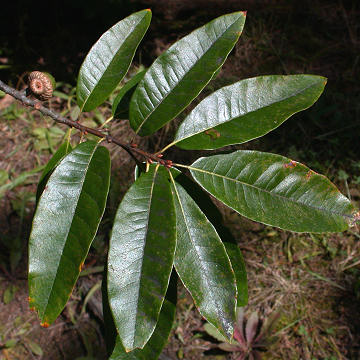

Quercus imbricaria - (image 1 of 4)
Taxonomy
Family: Fagaceae
Habitat
Dry woods; moist soil along streams or in woods; land adjacent to eroded farm land. Occasionally on dry, exposed cliffs.
Associates
Distribution
Eastern PA west to southern MI, Ontario and KS, south to NC, GA, and AR.
Morphology
Deciduous tree to 70' high. Bark gray with flat ridges and shallow furrows. Leaves dark green and shiny above with elevated veinlets, loosely pubescent below, alternate, simple, entire, bristle tipped, mostly 10-15 by 3.5-6 cm. Acorns dark brown, less than half enclosed by the slightly hairy, red-brown cup; scales few and broad.
Notes
Flowers early May to mid May
Wetland indicator: Facultative -
The only oak besides Quercus phellos L. (Willow Oak) that has unlobed leaves in the northeast, although a few other species with entire leaves occur from VA south. Fall color is brown, with the leaves persisting through most of the winter and sometimes into the spring.
References
Gleason, Henry A. and A. Cronquist. 1991. Manual of Vascular Plants of Northeastern United States and Adjacent Canada. Second Ed.
The New York Botanical Garden. Bronx, NY
IDNR. December 1995. Common Illinois Trees
Illinois Department of Educational Services.
Swink, F. and G. Wilhelm. 1994. Plants of the Chicago Region.
Indiana Academy of Science. The Morton Arboretum. Lisle, Illinois.
|
Michael Hough © 2005 |